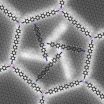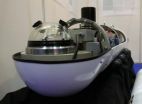(Press-News.org) In the nanoworld many things are different. Scientists only recently started unveiling and harnessing the underlying laws and principles. A team associated with Professor Johannes Barth from the Physics Department of the TU Muenchen have now succeeded in capturing rod-shaped molecules in a two-dimensional network in such a way that they autonomously form small rotors that turn in their honeycomb-like cages.
Nature itself provides the role model for such self-organizing systems. This is how proteins bring reactants so close together that reactions can take place – reactions that are possible only in very close proximity. These effects are put to use in catalysts: surface reactants find their way to each other on the surface of these facilitators. However, the coveted dream of using self-organization effects in such a way that nano machines assemble themselves is still a thing of the future.
The rotors developed in Garching are an important step in this direction. First, the physicists built up an extensive nano lattice by allowing cobalt atoms and rod-shaped molecules of sexiphenyl-dicarbonitrile to react with each other on a silver surface. This results in a honeycomb-like lattice of extreme regularity with astonishing stability. Just like graphene, for which its discoverers were awarded the Nobel Prize only a few weeks ago, this lattice is exactly one atom thick.
When the researchers added further molecular building blocks, the rods spontaneously gathered, typically in groups of three, in a honeycomb cell while neighboring cells remained empty. The chummy molecules must have had a reason for organizing themselves in threesomes. Under a scanning tunneling microscope the scientists were able to recognize why. The three molecules oriented themselves in such a way that the nitrogen ends each faced a phenyl-ring hydrogen atom. This triple-bladed rotor arrangement is so energetically advantageous that the molecules maintain this structure even when thermal energy drives it to rotation.
VIDEO:
Driven by thermal energy, the nano-rotors start rotating.
Click here for more information.
Because the honeycomb-cell is not round, but hexagonal, there are two different positions for the rotors that can be distinguished as a result of the interactions between the outer nitrogen atoms and the hydrogen atoms of the cell wall. Furthermore, the three molecules arrange in a clockwise and a counter-clockwise manner. In experiments at various carefully controlled temperatures the physicists were able to "freeze" all four states and examine them closely. They could thus determine the energy of these thresholds from the temperature at which the rotation resumed.
"We hope that in future we will be able to extend these simple mechanical models to optical or electronic switching," says Professor Johannes Barth. "We can set a specific cell size, we can specifically bring in further molecules and study their interaction with the surface and the cell wall. These self-organizing structures hold enormous potential."
INFORMATION:
The research was funded by the European Union (ERC Advanced Grant MolArt), as well as from the Institute for Advanced Study (TUM-IAS), the International Graduate School for Science and Engineering (IGSSE) and the Catalysis Research Center (CRC) at the TU Muenchen. The publication resulted from the collaboration with scientists at the Institute of Nanotechnology of the Karlsruhe Institute of Technology and the Institute of Material Physics and Chemistry of the University of Strasbourg.
Self-assembly of nano-rotors
Mechanical engineering at the molecular level
2010-11-24
ELSE PRESS RELEASES FROM THIS DATE:
Expecting? Don't neglect your teeth
2010-11-24
CHICAGO (November 23, 2010) - Even though most people are aware that good oral health is essential for the overall health of both mother and child, misunderstandings about the safety of dental care during pregnancy may cause pregnant women to avoid seeing their dentist. The fact is that dentists can create a treatment plan that is safe, effective, and essential for combating the adverse effects of oral disease during pregnancy.
During the course of pregnancy, a woman's oral health can undergo significant changes. According to an article published in the November/December ...
Underwater robots on course to the deep sea
2010-11-24
Even when equipped with compressed-air bottles and diving regulators, humans reach their limits very quickly under water. In contrast, unmanned submarine vehicles that are connected by cable to the control center permit long and deep dives. Today remote-controlled diving robots are used for research, inspection and maintenance work. The possible applications of this technology are limited, however, by the length of the cable and the instinct of the navigator. No wonder that researchers are working on autonomous underwater robots which orient themselves under water and carry ...
LSU sociologist produces documentary on Kenyan election violence
2010-11-24
While Africa is certainly no stranger to violence, the response to the Kenyan presidential elections of 2007 came as a surprise. Political unrest evolved into outright and unmitigated violence, marring the relatively peaceful history of Kenya's educated and mainly urban population. During allegations of voter manipulation and election fraud, two of Kenya's largest tribes, the Kalenjin and the Kikuyu, found themselves divided by anger, fueled by another tribe's promises of power and control.
Wesley Shrum, LSU professor of sociology, had experience dealing with human tragedy ...
ISU researcher, collaborators, re-sequence 6 corn varieties, find some genes missing
2010-11-24
AMES, Iowa - Most living plant and animal species have a certain, relatively small, amount of variation in their genetic make-up.
Differences in height, skin and eye color of humans, for example, are very noticeable, but are actually the consequences of very small variations in genetic makeup.
Researchers at Iowa State University, China Agricultural University and the Beijing Genomics Institute in China recently re-sequenced and compared six elite inbred corn (maize) lines, including the parents of the most productive commercial hybrids in China.
When comparing the different ...
Monitoring wear in helicopters -- and hips, knees and ankles, too
2010-11-24
Tel Aviv -- Ferrography, a practice used by the American and Israeli air forces to monitor the condition of machinery, extracts tiny iron particles from lubricants such as oil and grease to analyze wear in machines. Determining whether a system requires preventative maintenance can be the key to preventing catastrophic failure.
Now Tel Aviv University scientists are exploring a modification of this technique for human analysis -- called "bio-ferrography" -- to diagnose diseases in their early stages, determine the efficacy of drugs, and ascertain the condition of orthopedic ...
75 percent of Spanish zoos at risk of exotic animals escaping
2010-11-24
Lions, bears, monkeys, crocodiles, parrots and iguanas may seem inoffensive at first glance when they're behind bars in zoos. But some exotic species can escape and become invasive species. This has been confirmed by a scientific team that has checked 1,568 animal houses in 63 Spanish zoos. Birds are the animals most likely to escape.
"As zoos house a large number of exotic (non-indigenous) species, they could become an entry channel for these species if they escape, with the potential environmental risk that this implies", María C. Fàbregas, lead author of the study ...
BUSM investigates cellular mechanisms leading to immune response in airway epithelium
2010-11-24
(Boston) – Researchers from the Boston University School of Medicine (BUSM) have demonstrated that commensal species of the genus Neisseriae are low inducers of human airway epithelial cell responses as compared to the pathogenic species. Specifically, the study indicates that a Neisserial outer membrane component appears to play a differential role in the host inflammatory responses via interaction with a receptor on the surface of human airway epithelial cells.
Paola Massari, an assistant professor in the section of infectious diseases at BUSM, is lead author of this ...
CCNY chemists design molecule that responds to stimuli
2010-11-24
The venus flytrap plant captures its prey when it senses the presence of an insect on the tips of its leaves. An amphiphilic molecule designed by chemists at The City College of New York acts in a similar manner by changing its structure when heated slightly and, then, reverting to its original form when cooled.
The finding, reported in the journal Angewandte Chemie, points toward the possibility of designing adaptive soft materials in the lab that take their cues from how nature responds to stimuli, said Dr. George John, associate professor and corresponding author.
Professor ...
Alcohol consumption decreases with the development of disease
2010-11-24
In a cross-sectional study from the 2004 and 2007 Australian National Drug Strategy Household (NDSH) surveys, respondents were questioned about their current and past drinking, the presence of formal diagnosis for specific diseases (heart disease, type 2 diabetes, hypertension, cancer, anxiety, depression) and self-perceived general health status. The sample sizes for the 2004 and 2007 NDSH surveys were 24,109 and 23,356, respectively.
The authors report that respondents with a diagnosis of diabetes, hypertension, or anxiety were more likely to have reduced or stopped ...
Plant-derived scavengers prowl the body for nerve toxins
2010-11-24
The brain is forever chattering to itself, via electrical impulses sent along its hard-wired neuronal "Ethernet." These e-messages are translated into chemical transmissions, allowing communication across the narrow cleft separating one neuron from another or between neurons and their target cells. Of the many kinds of molecules involved in this lively chemical symposium, acetylcholine is among the most critical, performing a host of functions in the central and peripheral nervous system. This delicate cholinergic design however is highly vulnerable. It can fall victim ...
LAST 30 PRESS RELEASES:
Sleeping in on weekends may help boost teens’ mental health
Study: Teens use cellphones for an hour a day at school
After more than two years of war, Palestinian children are hungry, denied education and “like the living dead”
The untold story of life with Prader-Willi syndrome - according to the siblings who live it
How the parasite that ‘gave up sex’ found more hosts – and why its victory won’t last
When is it time to jump? The boiling frog problem of AI use in physics education
Twitter data reveals partisan divide in understanding why pollen season's getting worse
AI is quick but risky for updating old software
Revolutionizing biosecurity: new multi-omics framework to transform invasive species management
From ancient herb to modern medicine: new review unveils the multi-targeted healing potential of Borago officinalis
Building a global scientific community: Biological Diversity Journal announces dual recruitment of Editorial Board and Youth Editorial Board members
Microbes that break down antibiotics help protect ecosystems under drug pollution
Smart biochar that remembers pollutants offers a new way to clean water and recycle biomass
Rice genes matter more than domestication in shaping plant microbiomes
Ticking time bomb: Some farmers report as many as 70 tick encounters over a 6-month period
Turning garden and crop waste into plastics
Scientists discover ‘platypus galaxies’ in the early universe
Seeing thyroid cancer in a new light: when AI meets label-free imaging in the operating room
Neutrophil-to-lymphocyte ratio may aid risk stratification in depressive disorder
2026 Seismological Society of America Annual Meeting
AI-powered ECG analysis offers promising path for early detection of chronic obstructive pulmonary disease, says Mount Sinai researchers
GIMM uncovers flaws in lab-grown heart cells and paves the way for improved treatments
Cracking the evolutionary code of sleep
Medications could help the aging brain cope with surgery, memory impairment
Back pain linked to worse sleep years later in men over 65, according to study
CDC urges ‘shared decision-making’ on some childhood vaccines; many unclear about what that means
New research finds that an ‘equal treatment’ approach to economic opportunity advertising can backfire
Researchers create shape-shifting, self-navigating microparticles
Science army mobilizes to map US soil microbiome
Researchers develop new tools to turn grain crops into biosensors
[Press-News.org] Self-assembly of nano-rotorsMechanical engineering at the molecular level





